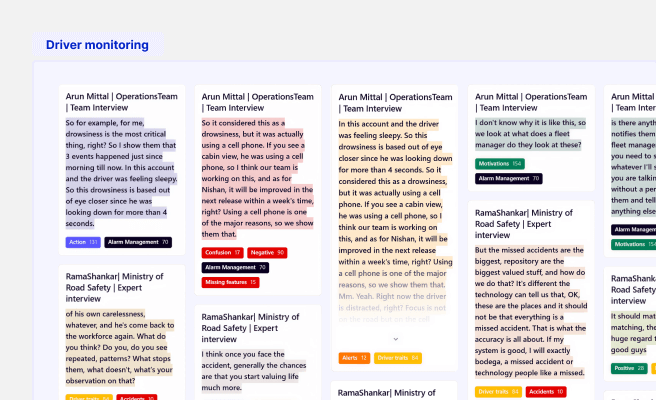Interaction Model
<p>Interaction model refers to the framework or blueprint that defines how users interact with a system, application, or product. It is fundamental in product design, especially for digital products, as it shapes the overall user experience. A well-designed interaction model ensures that users can navigate and use a product efficiently and intuitively.</p>
<p>Historically, interaction models have evolved significantly, especially with the advent of new technologies. Early models were primarily linear and command-based, while contemporary models emphasize intuitive gestures and natural language processing. Understanding the evolution of interaction models is crucial for leveraging historical insights to innovate modern solutions.</p>
<h2>Importance of Interaction Models in Product Design</h2>
<p>An interaction model is essential as it directs the flow of user interactions and ensures consistency across the product. It helps product managers and designers forecast how users will interact with their products, which can help in identifying potential friction points and areas for improvement. For instance, a <a href="https://www.nngroup.com/articles/ux-research-cheat-sheet/" style="color:#2896FF; text-decoration:underline;">UX research</a> study can reveal user behavior patterns which can then be mapped onto an interaction model to enhance the user experience.</p>
<h3>Components of an Interaction Model</h3>
<p>Several key components make up an effective interaction model:</p>
<ul>
<li><strong>User Goals:</strong> Understanding what users aim to achieve with the product.</li>
<li><strong>System Feedback:</strong> Providing users with immediate and clear feedback on their actions.</li>
<li><strong>Control Mechanisms:</strong> Tools and elements like buttons, sliders, and gestures that allow users to interact with the product.</li>
<li><strong>Navigation:</strong> Structuring the paths and flows users will follow to accomplish their goals.</li>
</ul>
<h3>Types of Interaction Models</h3>
<p>Different types of interaction models serve various purposes, and selecting the right one depends on the product's goals and user needs:</p>
<ul>
<li><strong>Direct Manipulation:</strong> Users interact with visible objects on the screen through actions like dragging and dropping. This model is highly intuitive and commonly used in <a href="https://www.adobe.com/products/xd.html" style="color:#2896FF; text-decoration:underline;">design tools</a> like Adobe XD.</li>
<li><strong>Menu-Driven:</strong> Users select commands or actions from a list of options, typical in software applications and websites.</li>
<li><strong>Form-Fill:</strong> Users input data through forms, used extensively in e-commerce and data entry applications.</li>
<li><strong>Voice Interaction:</strong> Users give commands through voice, becoming increasingly popular with the rise of smart assistants like Amazon Alexa and Google Assistant.</li>
</ul>
<h3>Challenges in Designing Interaction Models</h3>
<p>Creating an effective interaction model comes with its challenges:</p>
<ul>
<li><strong>Complex User Needs:</strong> Users have diverse needs and preferences, making it challenging to design a one-size-fits-all model.</li>
<li><strong>Technology Constraints:</strong> The capabilities and limitations of the underlying technology can impact the interaction model's effectiveness.</li>
<li><strong>Consistency:</strong> Maintaining consistency across different parts of a product while keeping interactions intuitive and straightforward.</li>
</ul>
<h3>Practical Applications</h3>
<p>Interaction models have practical applications in various industries, including climate tech. For instance, a company like <a href="https://www.climateinteractive.org/" style="color:#2896FF; text-decoration:underline;">Climate Interactive</a> uses sophisticated interaction models to visualize climate data and help stakeholders make informed decisions. These models enable users to interact with complex datasets through intuitive controls and feedback mechanisms.</p>
<h3>Actionable Steps for Designing Interaction Models</h3>
<p>Here are some actionable steps for designing effective interaction models:</p>
<ul>
<li><strong>User Research:</strong> Conduct thorough user research to understand the target audience's goals and preferences.</li>
<li><strong>Prototyping:</strong> Create prototypes to test and iterate on different interaction models. Tools like <a href="https://www.figma.com/" style="color:#2896FF; text-decoration:underline;">Figma</a> can be invaluable in this process.</li>
<li><strong>Usability Testing:</strong> Perform usability testing to identify and fix issues before the final release.</li>
<li><strong>Feedback Loop:</strong> Establish a feedback loop to continuously gather user feedback and improve the interaction model.</li>
</ul>
<h2>Conclusion</h2>
<p>Interaction models play a critical role in product design by defining how users interact with a system. A well-thought-out interaction model can significantly enhance user satisfaction and efficiency. By understanding user goals, leveraging appropriate components, and overcoming design challenges, product managers and designers can create intuitive and effective interaction models. To delve deeper into improving your interaction models, consider exploring <a href="https://www.smashingmagazine.com/interaction-design-principles/" style="color:#2896FF; text-decoration:underline;">interaction design principles</a> and best practices.</p> <p>If you’re looking for inspiration to elevate customer and user experience for enterprise-grade products, View our work with the Ministry of Health of Saudi Arabia for curating the UX of an <a href="https://www.whatifdesign.co/work/enterprise-software-for-hospitals" style="color:#2896FF; text-decoration:underline;">Asset Management Tracking Platform</a></p>
<p>Ready to get started? <a href="https://cal.com/akhilak/what-if-design?duration=30" style="color:#2896FF; text-decoration:underline;">Book a 1:1 consultation call</a> with us today.</p>

Let's scale your impact with great design.
Free consultation, no sales pitch
Thank you! Your submission has been received!
Oops! Something went wrong while submitting the form.
Let’s talk
Nothing great is built alone.
Let’s connect about your vision, our work and how we can collaborate.
Get in touch

